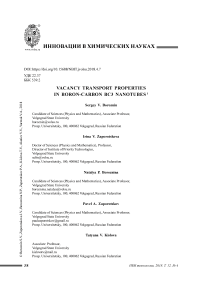Vacancy transport properties in boron-carbon bc3 nanotubes
Автор: Boroznin Sergey V., Zaporotskova Irina V., Boroznina Natalya P., Zaporotskov Pavel A., Kislova Tatyana V., Akatiev Vladimir V., Yarmak Vladimir A.
Журнал: НБИ технологии @nbi-technologies
Рубрика: Инновации в химических науках
Статья в выпуске: 4 т.12, 2018 года.
Бесплатный доступ
The paper presents results of theoretical research into vacancy formation in B type of boron-carbon nanotubes ВС n, where n = 3. The research was performed using the MNDO method within the framework of an ionic-embedded covalent-cyclic cluster model, molecular cluster model and DFT method. We found that when a V -defect (vacancy) is introduced in a boron-carbon nanotube, the band gap of the defective tubules increases. It means that physical properties of materials can be purposefully changed by introducing defects. Vacancy migration along the atomic bonds in the tubule was simulated and vacancy transport properties were studied. It was found that the defect migration along different bonds actually represents the process of carbon or boron ions hopping between their stable states on the nanotube surface. The calculated activation energy values revealed dependence of ionic conductivity in boron-carbon tubules on temperature.
Boron-carbon nanotubes, vacancy, v-defect, transport properties, ionic conductivity, activation energy, vacancy migration, semi-empirical methods of investigation, v-дефект
Короткий адрес: https://sciup.org/149129772
IDR: 149129772 | DOI: 10.15688/NBIT.jvolsu.2018.4.7
Список литературы Vacancy transport properties in boron-carbon bc3 nanotubes
- Debnarayan J., Sun C.-L., Chen L.-C., Chen K.-H. A comparative study of optical anisotropies of BC3 and B3C systems by density functional theory. Progress in Materials Science, 2013, no. 58, pp. 565-635.
- Dewar M.J.S., Thiel W., Amer J. Ground states of molecules. The MNDO method. Chem. Soc., 1977, no. 99, рр. 4899-4906.
- Fuentes G.G., Borowiak-Palen E., Knupfer M., Pichler T., Fink J., Wirtz L., Rubio A. Formation and electronic properties of BC3 single-wall nanotubes upon boron substitution of carbon nanotubes. Phys. Rev. B., 2004, no. 69, p. 245403.
- Кumar P., Yashonath S. Ionic conduction in the solid state. Chem J. Sci., 2006, no. 118 (1), pp. 135-154.
- Li Y.-T., Chen T.-C. Effect of B/N co-doping on the stability and electronic structure of single-walled carbon nanotubes by first-principles theory. Nanotechnology, 2009, no. 20, pp. 375705.
- MiyamotoY., RubioA., Louie S.G., Cohen M.L. Electronic properties of tubule forms of hexagonal BC3. Phys. Rev. B., 1994, no. 50, pp. 18360-18366.
- Wang R., Zhang D., Zhang Y., Liu C. A theoretical study of silicon-doped boron nitride nanotubes serving as a potential chemical sensor for hydrogen cyanide. J. Phys. Chem. B, 2006, no. 110, pp. 18267-71.
- Zaporotskova I.V. Carbon and uncarbon nanomaterials and composite structures on their base: structure and electronic properties. Volgograd, Izd-vo VolGU, 2009. 490 p.


